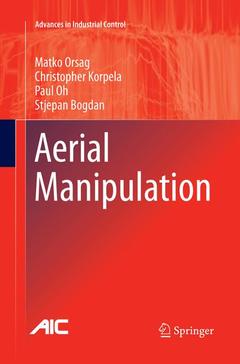Description
Aerial Manipulation, Softcover reprint of the original 1st ed. 2018
Advances in Industrial Control Series
Authors: Orsag Matko, Korpela Christopher, Oh Paul, Bogdan Stjepan
Language: English
Subjects for Aerial Manipulation:
121.31 €
In Print (Delivery period: 15 days).
Add to cartPublication date: 08-2018
Support: Print on demand
126.59 €
In Print (Delivery period: 15 days).
Add to cartPublication date: 10-2017
Support: Print on demand
Description
/li>Contents
/li>Biography
/li>Comment
/li>
This text is a thorough treatment of the rapidly growing area of aerial manipulation. It details all the design steps required for the modeling and control of unmanned aerial vehicles (UAV) equipped with robotic manipulators. Starting with the physical basics of rigid-body kinematics, the book gives an in-depth presentation of local and global coordinates, together with the representation of orientation and motion in fixed- and moving-coordinate systems. Coverage of the kinematics and dynamics of unmanned aerial vehicles is developed in a succession of popular UAV configurations for multirotor systems. Such an arrangement, supported by frequent examples and end-of-chapter exercises, leads the reader from simple to more complex UAV configurations. Propulsion-system aerodynamics, essential in UAV design, is analyzed through blade-element and momentum theories, analysis which is followed by a description of drag and ground-aerodynamic effects.
The central part of the book is dedicated to aerial-manipulator kinematics, dynamics, and control. Based on foundations laid in the opening chapters, this portion of the book is a structured presentation of Newton?Euler dynamic modeling that results in forward and backward equations in both fixed- and moving-coordinate systems. The Lagrange?Euler approach is applied to expand the model further, providing formalisms to model the variable moment of inertia later used to analyze the dynamics of aerial manipulators in contact with the environment. Using knowledge from sensor data, insights are presented into the ways in which linear, robust, and adaptive control techniques can be applied in aerial manipulation so as to tackle the real-world problems faced by scholars and engineers in the design and implementation of aerial robotics systems. The book is completed by path and trajectory planning with vision-based examples for tracking and manipulation.
Matko Orsag received his Ph.D.E.E. (2008) and B.Sc.E.E. (2003) from the Faculty of Electrical Engineering and Computing, University of Zagreb. Currently he is working as an Assistant Professor at the Laboratory for Robotics and Intelligent Control Systems (LARICS), Faculty of Electrical Engineering and Computing, University of Zagreb. He graduated summa cum laude for which he received the Josip Loncar bronze plaque. During his undergraduate studies he participated in scientific research, published several papers and received the Rector Award in 2007. In 2011/2012 he worked as a visiting researcher at Drexel University, Philadelphia, PA, USA as a recipient of the Fulbright exchange grant. As a researcher, he participated in several national and international research projects in the field of robotics, control and automation. He authored and coauthored over 20 scientific and professional papers, including journal and conference papers, as well as book chapters in the field of unmanned aerial systems and robotics. He is a member of IEEE and is currently serving as a vice-chair of IEEE Coroatian RAS section.
Christopher Korpela received his PhD.EE (2014) from Drexel University, MS.EE (2006) from the University of Colorado at Boulder, and BS.EE (1996) from the United States Military Academy at West Point. Lieutenant Colonel Korpela is an active duty Army officer and Academy Professor currently serving as the Deputy Director of the Electrical Engineering Program at West Point. Between 2015 and 2016, he collaborated with the Philosophy Program and brought together engineers and ethicists to study Just War Theory and autonomous weapons. The collaboration resulted in receiving the Apgar Award, West Point’s highest teaching award. In 2017, he became the founding director of the Robotics Research Center at West Point. Lieutenant Colonel Korpela has deployed twice to Iraq and served in command and staff positions from company to division level. As a researcher, he h
These books may interest you

Design of Unmanned Aerial Systems 139.64 €

Unmanned Rotorcraft Systems 147.88 €


